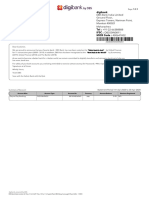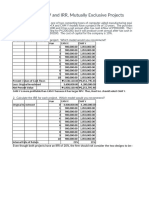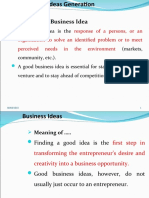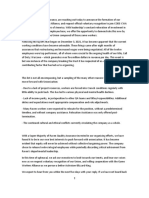Module 2 Intermediate Accounting 3
Uploaded by
zeinnkianModule 2 Intermediate Accounting 3
Uploaded by
zeinnkianRepublic of the Philippines
Laguna State Polytechnic University
Province of Laguna
ISO 9001:2015 Certified
Level I Institutionally Accredited
LSPU Self-Paced Learning Module (SLM)
Course Intermediate Accounting 3 (AE17)
Sem/AY First Semester/2024 - 2025
Module No. 2
Lesson Title Statement of Financial Position
Week
3
Duration
Date
Description This lesson will discuss the preparation of the statement of financial position and the
of the related notes.
Lesson
Learning Outcomes
Intended Students should be able to meet the following intended learning outcomes:
Learning • Identify each classification in the statement of financial position and the items
Outcomes which must appear in each one
• Prepare a properly classified statement of financial position and in accordance
with the provisions of PAS No.1
• Demonstrate understanding on which information needs to be presented in the
notes
Targets/ At the end of the lesson, students should be able to:
Objectives • Prepare properly classified statement of financial position
• Prepare notes to financial statements
Student Learning Strategies
Online Activities (Synchronous / Asynchronous)
A. Online Discussion via Google Meet
You will be directed to attend in a one-hour class discussion on the statement of
financial position and notes. To have access to the Online Discussion, refer to this
link: ____________________.
The online discussion will happen on ________, 2023, from ________AM.
(For further instructions, refer to your Google Classroom and see the schedule of
activities for this module)
LSPU SELF-PACED LEARNING MODULE: INTERMEDIATE ACCOUNTING 3
Republic of the Philippines
Laguna State Polytechnic University
Province of Laguna
ISO 9001:2015 Certified
Level I Institutionally Accredited
B. Learning Guide Questions:
1. What are the minimum information required to be included in the face of the
statement of financial position?
2. What is the relevance of classifying assets/liabilities as current and non-current?
3. What are the items to be included in the notes to financial statements?
Note: The insight that you will post on online discussion forum using Learning Management System (LMS) will
receive additional scores in class participation.
Offline Activities (e-Learning / Self-Paced)
Lecture Guide
Structure and content of financial statements in general
Philippine Accounting Standards (PAS 1) requires an entity to clearly identify: (PAS 1.49-
51) the financial statements, which must be distinguished from other information in a
published document each financial statement and the notes to the financial statements. In
addition, the following information must be displayed prominently, and repeated as
necessary: (PAS 1.51)
- the name of the reporting entity and any change in the name
- whether the financial statements are a group of entities or an individual entity
- information about the reporting period
- the presentation currency (as defined by PAS 21 The Effects of Changes in
Foreign Exchange Rates)
- the level of rounding used (e.g. thousands, millions).
Current/Non-current Distinction
• Present assets and liabilities separately under current and non-current
classification unless presentation based on liquidity is reliable and more relevant.
• Assets and liabilities shall be presented in order of approximate liquidity
(ascending or descending)
Classify assets and liabilities as current if they are:
• Involved in the operating cycle
• Expected to be realized or settled within twelve months from the
reporting date.
Classify an asset as current when:
• It is cash or a cash equivalent (unless restricted)
• It is held primarily for the purpose of trading
• It is expected to be realized, sold or consumed within the entity’s normal
operating cycle
• It is expected to be realized within twelve months after the reporting date
LSPU SELF-PACED LEARNING MODULE: INTERMEDIATE ACCOUNTING 3
Republic of the Philippines
Laguna State Polytechnic University
Province of Laguna
ISO 9001:2015 Certified
Level I Institutionally Accredited
Classify all other assets as non-current
Classify a liability as current when:
• It is expected to be settled in the entity’s normal operating cycle
• It is held primarily for the purpose of trading
• It is expected to be settled within twelve months after the reporting date
• The entity does not have an unconditional right to defer settlement of the
liability for at least twelve months after reporting date
Classify all other liabilities as non-current
• When a long-term debt is expected to be refinanced under an existing loan facility,
and the entity has the discretion to do so, the debt is classified as non-current, even
if the liability would otherwise be due within 12 months (PAS 1.73)
• If a liability has become payable on demand because an entity has breached an
undertaking under a long-term loan agreement on or before reporting date, the
liability is current, even if the lender has agreed, after the reporting date and before
the authorization of the financial statement for issue, not to demand payment as a
consequence of the breach (PAS 1.74)
• The liability is classified as non-current if the lender agreed by the reporting date to
provide a period of grace ending in at least 12 months after the end of the reporting
period, within which the entity can rectify the breach and during which the lender
cannot demand immediate repayment.(PAS 1.75)
• Settlement by the issue of equity instruments does not impact classification (PAS
1.76B)
Presentation of Items in the Statement of Financial Position
• Present material items of different nature or function separately
• PFRS does not prescribe sequence or format of presentation
Sub-classification of Assets
• Trade and other receivables showing separately:
o Amounts receivable from trade customers
o Amounts due from related parties
o Amounts due from other parties
o Receivables arising from accrued income not yet billed
• Inventories
o Held for sale in the ordinary course of business
o In the process of production for such sale
o In the form of materials and supplies to be consumed in the production
process or rendering of services
• Property, plant and equipment in classifications appropriate to the entity
Sub-classsification of liabilities
• Trade and other payables showing separately:
LSPU SELF-PACED LEARNING MODULE: INTERMEDIATE ACCOUNTING 3
Republic of the Philippines
Laguna State Polytechnic University
Province of Laguna
ISO 9001:2015 Certified
Level I Institutionally Accredited
o Amount payable to trade creditors
o Amounts payable to related parties
o Deferred income
o Accrual
• Provision for employee benefits and other provision
• Classes of equity
o Paid-in capital
o Share premium
o Retained earnings
o Income and expenses recognized in other comprehensive income
• Classes of equity
o Paid-in capital
o Share premium
o Retained earnings
o Income and expenses recognized in other comprehensive income
• For each class of share capital:
o Number of shares authorized
o Number of shares issued
o Par value per share
o Reconciliation of number of shares outstanding at the beginning and at the
end of the period.
o Rights, preferences and restrictions attaching to that class
o Treasury shares or shares held by its subsidiary or associates
o Shares reserved for issue under options and contracts for the sale of shares
including terms and amounts
• A description of each reserved in the equity
Format of Statement
PAS 1 does not prescribe the format of the statement of financial position. Assets can be
presented current then non-current, or vice versa and liabilities and equity can be
presented current then non-current then equity, or vice versa. A net asset presentation
(assets minus liabilities) is allowed. The long-term financing approach used in UK and
elsewhere – fixed assets +current assets-short term payables = long term debt plus equity,
is also acceptable.
Engaging Activities
To be posted online using Google classroom
LSPU SELF-PACED LEARNING MODULE: INTERMEDIATE ACCOUNTING 3
Republic of the Philippines
Laguna State Polytechnic University
Province of Laguna
ISO 9001:2015 Certified
Level I Institutionally Accredited
Performance Tasks
Multiple Choice questions to be given ONLINE, either Google classroom-based or through
any other online software formats, if LMS is not feasible.
LSPU SELF-PACED LEARNING MODULE: INTERMEDIATE ACCOUNTING 3
Republic of the Philippines
Laguna State Polytechnic University
Province of Laguna
ISO 9001:2015 Certified
Level I Institutionally Accredited
Understanding Directed Assessment
Rubrics
Criteria 4 3 2 1
Identified Correctly identified Correctly identified Made at least one Answer was
and proper accounting proper accounting, major mistake mostly wrong;
addressed and supporting but left out minor or with clear that
accounting details. supporting details identification, student did not
issues estimation, or know how to
proper accounting conceptualize or
approach
problem.
Standards Identified and Identified and At least one major Many mistakes
and Rules assessed all assessed most omission when when identifying
relevant standards relevant standards identifying and and assessing
and rules and rules; made assessing relevant relevant
minor mistakes standards and standards and
rules rules
Measurement Used the most Used acceptable Made one or more Failed to identify
and relevant and reliable and relevant major mistakes or use reliable
Disclosures reliable measurement and per relevant and measurement
measurement and disclosure criteria; reliable and disclosure
disclosure criteria minor mistakes or measurement and criteria
omissions disclosure criteria
Logical Completely and Acceptable job of Major omissions Was mostly or
Inference correctly analogized analogizing from when analogizing completely
from existing rules existing rules to from existing unable to
to situations not situations not rules to situations analogize from
explicitly addressed explicitly addressed not explicitly existing rules to
by current by standards and addressed by situations not
standards or authoritative standards and covered by
authoritative sources; left out authoritative standards and
sources. some details or sources authoritative
reasoning. sources
Learning Resources
LSPU SELF-PACED LEARNING MODULE: INTERMEDIATE ACCOUNTING 3
Republic of the Philippines
Laguna State Polytechnic University
Province of Laguna
ISO 9001:2015 Certified
Level I Institutionally Accredited
• Cabrera, Ma. Elenita; Ocampo, Reynaldo (2019) Conceptual Framework and Accounting
Standards,Manila: GIC Enterprises & Co., Inc
• MIllan, Zeus Vernon B (2019). Conceptual Framework & Accounting Standards.
Bandolin Enterprise.
• Millan, Zeus Vernon B (2019).Intermediate Accounting Volume 3. Bandolin Enterprise.
• Robles. N. and Empleo, P. (2019) Intermediate Accounting Volume 3. Mutual Books, Inc.
• Valix, C. & Valix, C. (2018).Financial Accounting Volume 3. Manila: GIC Enterprises & Co.,
Inc.
• Philippine Accounting Standards (PAS) and Philippine Financial Reporting Standards
(PFRS) issued by FRSC.
• International Accounting Standards (IAS) and International Financial Reporting
Standards (IFRS) issued by IASB.
• SIC and IFRIC issued by IASC and IASB
• PIC Questions and Answers prepared by PIC and approved by FRSC
• www.iasplus.com
This module is for educational purpose only. Under section 185 of R.A. 8293, which states,
“The fair use of a copyrighted work for criticism, comment, news reporting, teaching
including multiple copies for classroom use, scholarship, research, and similar purposes is
not an infringement of copyright”. The unauthorized reproduction, use and dissemination
of this module, without joint consent of the authors and LSPU, is strictly prohibited and
shall be prosecuted to the full extent of the law, including appropriate administrative
sanctions, civil and criminal.
LSPU SELF-PACED LEARNING MODULE: INTERMEDIATE ACCOUNTING 3
You might also like
- DBS Bank India Limited Ground Floor, Express Towers, Nariman Point, Mumbai 400021 Maharashtra +91-22-66388888 DBSS0IN0811 400641002No ratings yetDBS Bank India Limited Ground Floor, Express Towers, Nariman Point, Mumbai 400021 Maharashtra +91-22-66388888 DBSS0IN0811 4006410024 pages
- Module 3 Intermediate Accounting 3 RevisedNo ratings yetModule 3 Intermediate Accounting 3 Revised6 pages
- Module 1 Financial Analysis and ReportingNo ratings yetModule 1 Financial Analysis and Reporting39 pages
- Earning Outcomes: LSPU Self-Paced Learning Module (SLM)No ratings yetEarning Outcomes: LSPU Self-Paced Learning Module (SLM)20 pages
- Fundamentals of Accountancy, Business and Management 2No ratings yetFundamentals of Accountancy, Business and Management 212 pages
- Module 3 Banking and Financial InstitutionNo ratings yetModule 3 Banking and Financial Institution19 pages
- Intermediate Accounting 2: Carmela L. PeducheNo ratings yetIntermediate Accounting 2: Carmela L. Peduche9 pages
- Pas 1 - Presentation of Financial Statements100% (1)Pas 1 - Presentation of Financial Statements27 pages
- Module 2 Accounting For Service BusinessNo ratings yetModule 2 Accounting For Service Business20 pages
- Chapter_9A_ Presentation of Financial StatementsNo ratings yetChapter_9A_ Presentation of Financial Statements82 pages
- Module 2 Accounting For Service Business PDF67% (3)Module 2 Accounting For Service Business PDF20 pages
- FA - SNU - Course Outline - Monsoon 2023No ratings yetFA - SNU - Course Outline - Monsoon 20236 pages
- Structuring Your Portfolio of Evidence File: Unit Standard: 116345No ratings yetStructuring Your Portfolio of Evidence File: Unit Standard: 11634559 pages
- Pas 1 Presentation of Financial Statements - 150413098No ratings yetPas 1 Presentation of Financial Statements - 15041309828 pages
- Pas 1 - Presentation of Financial StatementsNo ratings yetPas 1 - Presentation of Financial Statements30 pages
- IAS1 Presentation of Financial StatementsNo ratings yetIAS1 Presentation of Financial Statements78 pages
- Module FINANCIAL MANAGEMENT FM101 Module 2No ratings yetModule FINANCIAL MANAGEMENT FM101 Module 216 pages
- Lesson 1 Statement of Financial PositionNo ratings yetLesson 1 Statement of Financial Position30 pages
- PAS 1 Presentation of Financial Statements 2020No ratings yetPAS 1 Presentation of Financial Statements 202030 pages
- Portfolio of Evidence_Guide_US 116345_DecemberNo ratings yetPortfolio of Evidence_Guide_US 116345_December44 pages
- Modules For Online Learning Management System: Computer Communication Development InstituteNo ratings yetModules For Online Learning Management System: Computer Communication Development Institute26 pages
- Financial Accounting I: Incoming 2 Year MAY 30 - 31, 2016No ratings yetFinancial Accounting I: Incoming 2 Year MAY 30 - 31, 201627 pages
- Module 25 Statement of Financial PositionNo ratings yetModule 25 Statement of Financial Position8 pages
- Grace Gural-Balaguer: Acctg 22 InstructorNo ratings yetGrace Gural-Balaguer: Acctg 22 Instructor59 pages
- POE U S 116345 Budgeting - group work doc Updated Nov 20111No ratings yetPOE U S 116345 Budgeting - group work doc Updated Nov 2011159 pages
- INSEAD Master in Finance Curriculum PDFNo ratings yetINSEAD Master in Finance Curriculum PDF25 pages
- IAS 1-Presentation of Financial Statements (1)No ratings yetIAS 1-Presentation of Financial Statements (1)25 pages
- Syllabus - Principles of Accounting I (ACCT2200-01 & 06 - Spring 2021No ratings yetSyllabus - Principles of Accounting I (ACCT2200-01 & 06 - Spring 202110 pages
- Fundamentals of Accountancy, Business and Management 2No ratings yetFundamentals of Accountancy, Business and Management 28 pages
- Components of A Set of Financial Statements:: 1. Fair Presentation and Compliance With PFRSNo ratings yetComponents of A Set of Financial Statements:: 1. Fair Presentation and Compliance With PFRS7 pages
- Summary of Key Provisions of IAS & IFRS Which May Be Relevant To ACCA Financial Reporting and Audit Papers For 2013 ExaminationsNo ratings yetSummary of Key Provisions of IAS & IFRS Which May Be Relevant To ACCA Financial Reporting and Audit Papers For 2013 Examinations11 pages
- ACCY901 Accounting Foundations For Professionals: Topic 1100% (1)ACCY901 Accounting Foundations For Professionals: Topic 126 pages
- Financial Reporting and Statement Analysis Important Questions With AnswersNo ratings yetFinancial Reporting and Statement Analysis Important Questions With Answers17 pages
- IM ACCO 20033 Financial Accounting and Reporting Part 1No ratings yetIM ACCO 20033 Financial Accounting and Reporting Part 195 pages
- UNESCO Working Group On Education: Digital Skills For Life and WorkNo ratings yetUNESCO Working Group On Education: Digital Skills For Life and Work128 pages
- Assignment 1: NPV and IRR, Mutually Exclusive Projects: Net Present Value 1,930,110.40 2,251,795.460% (1)Assignment 1: NPV and IRR, Mutually Exclusive Projects: Net Present Value 1,930,110.40 2,251,795.463 pages
- Assignment 01 - The Evolution and Development of Public Administration As An Academic DisciplineNo ratings yetAssignment 01 - The Evolution and Development of Public Administration As An Academic Discipline7 pages
- Bachelor of Travel and Tourism ManagementNo ratings yetBachelor of Travel and Tourism Management2 pages
- Lecture Notes On Biological Assets and Agricultural Produce - 000No ratings yetLecture Notes On Biological Assets and Agricultural Produce - 0005 pages
- DBS Bank India Limited Ground Floor, Express Towers, Nariman Point, Mumbai 400021 Maharashtra +91-22-66388888 DBSS0IN0811 400641002DBS Bank India Limited Ground Floor, Express Towers, Nariman Point, Mumbai 400021 Maharashtra +91-22-66388888 DBSS0IN0811 400641002
- Earning Outcomes: LSPU Self-Paced Learning Module (SLM)Earning Outcomes: LSPU Self-Paced Learning Module (SLM)
- Fundamentals of Accountancy, Business and Management 2Fundamentals of Accountancy, Business and Management 2
- Structuring Your Portfolio of Evidence File: Unit Standard: 116345Structuring Your Portfolio of Evidence File: Unit Standard: 116345
- Pas 1 Presentation of Financial Statements - 150413098Pas 1 Presentation of Financial Statements - 150413098
- Modules For Online Learning Management System: Computer Communication Development InstituteModules For Online Learning Management System: Computer Communication Development Institute
- Financial Accounting I: Incoming 2 Year MAY 30 - 31, 2016Financial Accounting I: Incoming 2 Year MAY 30 - 31, 2016
- POE U S 116345 Budgeting - group work doc Updated Nov 20111POE U S 116345 Budgeting - group work doc Updated Nov 20111
- Syllabus - Principles of Accounting I (ACCT2200-01 & 06 - Spring 2021Syllabus - Principles of Accounting I (ACCT2200-01 & 06 - Spring 2021
- Fundamentals of Accountancy, Business and Management 2Fundamentals of Accountancy, Business and Management 2
- Components of A Set of Financial Statements:: 1. Fair Presentation and Compliance With PFRSComponents of A Set of Financial Statements:: 1. Fair Presentation and Compliance With PFRS
- Summary of Key Provisions of IAS & IFRS Which May Be Relevant To ACCA Financial Reporting and Audit Papers For 2013 ExaminationsSummary of Key Provisions of IAS & IFRS Which May Be Relevant To ACCA Financial Reporting and Audit Papers For 2013 Examinations
- ACCY901 Accounting Foundations For Professionals: Topic 1ACCY901 Accounting Foundations For Professionals: Topic 1
- Financial Reporting and Statement Analysis Important Questions With AnswersFinancial Reporting and Statement Analysis Important Questions With Answers
- IM ACCO 20033 Financial Accounting and Reporting Part 1IM ACCO 20033 Financial Accounting and Reporting Part 1
- MONEY MASTERY 101: Financial Planning for BeginnersFrom EverandMONEY MASTERY 101: Financial Planning for Beginners
- UNESCO Working Group On Education: Digital Skills For Life and WorkUNESCO Working Group On Education: Digital Skills For Life and Work
- Assignment 1: NPV and IRR, Mutually Exclusive Projects: Net Present Value 1,930,110.40 2,251,795.46Assignment 1: NPV and IRR, Mutually Exclusive Projects: Net Present Value 1,930,110.40 2,251,795.46
- Assignment 01 - The Evolution and Development of Public Administration As An Academic DisciplineAssignment 01 - The Evolution and Development of Public Administration As An Academic Discipline
- Lecture Notes On Biological Assets and Agricultural Produce - 000Lecture Notes On Biological Assets and Agricultural Produce - 000

























































































